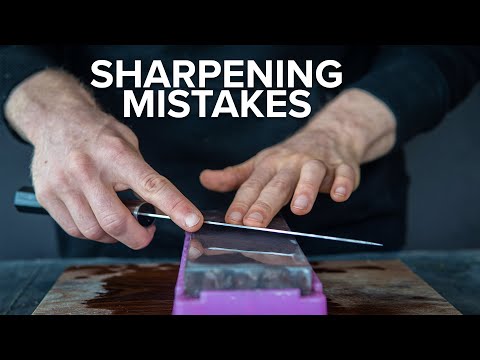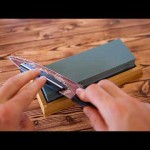
a9ced387245c55599664c431f0a9cb06
Sharpening stones are an essential tool for any knife enthusiast. Whether you are a professional chef, a home cook, or a hobbyist, having the right sharpening stone can make all the difference in the quality of your knife’s edge. But with so many different types of sharpening stones available, it can be difficult to know which one is right for you. In this guide, we will discuss the different types of grit sharpening stones, what they are used for, and which one is best for your needs. We will also provide tips on how to use and maintain your sharpening stone to ensure it lasts for years to come.
What grit stone should you start with
Sharpening knives is an important skill to have, and it’s important to know which grit stone to start with. The grit of a stone is the measure of how coarse or fine the particles are. The lower the number, the coarser the stone. The higher the number, the finer the stone.
When it comes to sharpening knives, it’s best to start with a coarse stone. A stone with a grit of around 400-800 is a good starting point. This will help to remove any nicks or chips in the blade quickly and efficiently. It will also help to create a new bevel on the blade.
Once the blade has been sharpened with the coarse stone, it’s time to move onto a finer stone. A stone with a grit of around 1000-2000 is ideal for this. This will help to refine the edge of the blade and make it sharper. It will also help to remove any burrs that may have been created during the sharpening process.
Finally, it’s a good idea to finish off the sharpening process with a very fine stone. A stone with a grit of around 3000-5000 is ideal for this. This will help to polish the edge of the blade and make it even sharper. It will also help to protect the blade from corrosion.
In conclusion, when it comes to sharpening knives, it’s best to start with a coarse stone with a grit of around 400-800. Once the blade has been sharpened with the coarse stone, it’s time to move onto a finer stone with a grit of around 1000-2000. Finally, it’s a good idea to finish off the sharpening process with a very fine stone with a grit of around 3000-5000.
What is better 6000 or 1000 grit sharpening stone
Sharpening stones are an essential tool for any knife enthusiast. They come in a variety of grits, ranging from coarse to fine. The two most common grits are 1000 and 6000. Each has its own advantages and disadvantages, so it is important to understand the differences between them before making a purchase.
1000 Grit Sharpening Stone
A 1000 grit sharpening stone is a coarse stone that is used to quickly sharpen a dull blade. It is best used for knives that are very dull or have nicks in the blade. It is also great for removing rust or corrosion from a blade. The downside of a 1000 grit stone is that it can leave a rough finish on the blade, which may require additional polishing.
6000 Grit Sharpening Stone
A 6000 grit sharpening stone is a much finer stone than the 1000 grit. It is used to refine the edge of a blade and give it a polished finish. It is best used for knives that are already sharp, but need a bit of extra refinement. The downside of a 6000 grit stone is that it can take longer to sharpen a blade than a 1000 grit stone.
Which is Better?
The answer to this question depends on the type of knife and the desired result. If you are looking for a quick sharpening job, then a 1000 grit stone is the best choice.
If you are looking for a polished finish, then a 6000 grit stone is the better option. Ultimately, it is up to the user to decide which grit is best for their needs.
What grit sharpening stones do I need for pocket knife
Sharpening a pocket knife is an important part of knife maintenance. To keep your pocket knife in top condition, you need to use the right sharpening stones. The type of stone you need depends on the type of pocket knife you have and the level of sharpness you want to achieve.
Types of Sharpening Stones
Sharpening stones come in a variety of grits, ranging from coarse to extra-fine. Coarse stones are typically used for removing nicks and chips from the blade, while finer stones are used for honing and polishing the blade. The most common types of sharpening stones are oil stones, water stones, and diamond stones.
Choosing the Right Grit
When choosing a sharpening stone for your pocket knife, it’s important to consider the type of blade you have. For a pocket knife with a stainless steel blade, a medium-grit stone is usually sufficient. If you have a carbon steel blade, you may need to use a finer stone.
For most pocket knives, a combination of two stones is recommended. Start with a coarse stone to remove any nicks or chips, then switch to a finer stone to hone and polish the blade. A combination of a 1000-grit and a 6000-grit stone is a good choice for most pocket knives.
Sharpening Techniques
Once you have the right sharpening stones, it’s important to use the correct sharpening technique. Start by lubricating the stone with oil or water, then hold the blade at a 20-degree angle against the stone. Move the blade in a circular motion, applying light pressure.
After a few passes, check the blade for sharpness. If it’s not sharp enough, switch to the finer stone and repeat the process. When you’re finished, rinse the blade with water and dry it with a soft cloth.
Conclusion
Choosing the right sharpening stones for your pocket knife is essential for keeping it in top condition. For most pocket knives, a combination of a 1000-grit and a 6000-grit stone is recommended. Be sure to use the correct sharpening technique and lubricate the stone with oil or water before use.
Is 3000 grit whetstone enough
A whetstone is a tool used to sharpen knives, tools, and other blades. It is made of a hard material, usually a type of stone, and is used to grind and hone the blade. The coarseness of the stone is measured in grit, with higher numbers indicating a finer stone. A 3000 grit whetstone is considered to be a medium-fine stone, and is often used for sharpening and honing blades.
The 3000 grit whetstone is a good choice for most sharpening and honing tasks. It is not too coarse, so it will not damage the blade, but it is also not too fine, so it will still remove enough material to sharpen the blade. It is also a good choice for maintaining the edge of a blade, as it will not remove too much material.
When using a 3000 grit whetstone, it is important to use the correct technique. The blade should be held at a consistent angle and moved in a circular motion across the stone. This will ensure that the blade is sharpened evenly and that the edge is not damaged. It is also important to use enough pressure to ensure that the blade is sharpened properly.
In conclusion, a 3000 grit whetstone is a good choice for most sharpening and honing tasks. It is not too coarse, so it will not damage the blade, and it is not too fine, so it will still remove enough material to sharpen the blade. When using a 3000 grit whetstone, it is important to use the correct technique and enough pressure to ensure that the blade is sharpened properly.
We hope this guide has been helpful in understanding what grit sharpening stones you need. Thank you for reading and we wish you the best of luck in your sharpening endeavors! Goodbye and take care!















